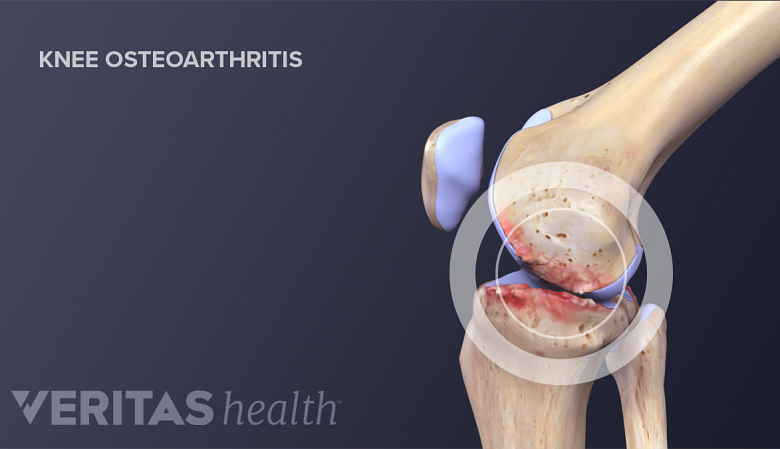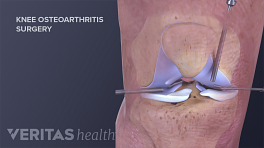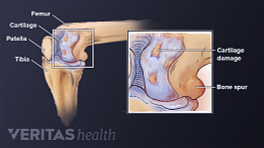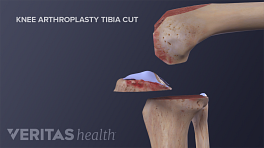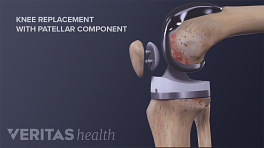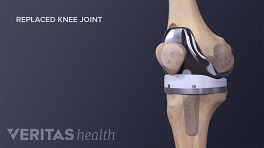Knee osteotomy is the cutting of bone to correct the knee’s alignment and improve its function with the goal of reducing chronic arthritis knee pain.
Knee osteotomy is an option for patients who have unilateral knee arthritis, meaning there is damage on just one side, or “compartment,” of the knee joint. The goal of the surgery is to shift some weight away from the painful, damaged side of the knee joint and onto the healthy side of the knee joint. The surgeon makes this possible by strategically cutting and altering the alignment or shape of a leg bone.
The two most common types of knee osteotomies are high tibial osteotomy, a reshaping of the shin bone, and femoral osteotomy, a reshaping of the thigh bone.
In This Article:
High tibial osteotomy
When a surgeon adds or removes a wedge of bone to an area of the tibia (shin bone) just below the knee, it is called a high tibial ostoetomy. This surgery is most often done to relieve pain, improve function, and correct bow-legged alignment.
Femoral osteotomy
When a surgeon adds or removes a wedge of bone to the femur (thigh bone), it is called a femoral osteotomy. Typically, the bone is cut just above the knee. Less common than tibial osteotomies, femoral osteotomies are usually done to correct a knock-kneed alignment, improve joint function, and relieve arthritis pain.
Knee arthritis is the degradation of cartilage in the knee. Exactly why knee arthritis causes knee pain can vary from person to person and is not always clear. Factors that are considered include:
- Inflammation as a result of a breakdown of knee cartilage
- Abnormal joint stress that strains the knee joint capsule, nearby ligaments, and other surrounding support structures (e.g. tendons)
- Bone pain caused by mechanical stress
Learn about the most common type of knee arthritis: Knee Osteoarthritis
By reshaping the bone and creating a more normal pattern of weight bearing, knee osteotomy may help eliminate or lessen these factors and relieve knee pain.
Knee Osteotomy vs. Knee Replacement
Knee osteoarthritis occurs when the knee's cartilage degenerates, causing inflammation and pain.
Knee osteotomy has become more common as the surgery has improved and surgical treatments for knee arthritis are more frequently used. The two primary reasons patients choose to have a knee osteotomy is that it preserves the natural tissue surrounding the knee and that it may postpone or eliminate the need for a knee replacement.
See Undergoing Total Knee Replacement for Knee Arthritis
A knee osteotomy allows the actual knee joint—where the tibia, femur and patella (kneecap) meet—and all of the knee’s ligaments, to remain intact. Conserving the knee optimizes joint function and preserves the natural feeling of the knee throughout a full range of motion. These factors can be important to patients who want to continue to do activities that require higher levels of knee function, such as running, squatting, kneeling, and climbing.
A knee osteotomy may eliminate or postpone the need for knee replacement surgery. Postponing knee replacement surgery is important to some patients, because while the typical artificial knee lasts 15 years or more, 1 Total Knee Replacement. American Academy of Orthopedic Surgeons. http://orthoinfo.aaos.org Last reviewed December 2011. Accessed September 27, 2012. , 2 NIH Consensus Development Conference on Total Knee Replacement. National Institutes of Health. http://consensus.nih.gov. Accessed December 28, 2011. , 3 "U.S. sees a run on new knees since 1990s." Medline, National Institutes of Health. http://www.nlm.nih.gov. Published September 25, 2012. it eventually may require a second surgery called a revision knee replacement surgery. Logically, patients want to make choices that will help them avoid the need for a revision knee replacement.
Potential Advantages and Disadvantages of Knee Osteotomy
For a select group of active knee arthritis patients under age 60, knee osteotomy is a reasonable surgical treatment option.
The potential advantages of knee osteotomy over knee replacement surgery are that:
- The actual knee joint, including ligaments, is preserved.
- Once healed, many patients can return to high-impact activities, such as jogging or playing basketball, which is not recommended after total knee replacements.
Compared to total knee replacement, knee osteotomy has potential disadvantages, including that it:
- Requires more healing time
- Is more prone to complications
- Requires the patient to use crutches during bone healing
- Depends on successful bone healing, and there are many factors which regulate bone healing, not all of which are known or controlled
- Is less dependable for pain relief (and then a partial or total knee replacement may be recommended)
- Is not a cure for arthritis
- Does not replace the cartilage that is already lost or repair the remaining cartilage
In addition, an osteotomy usually just delays the need for a total knee replacement. Knee osteotomy results vary but typically last for about 10 years, 4 J. N. Insall, D. M. Joseph, and C. Msika, "High tibial osteotomy for varus gonarthrosis: a long-term follow-up study," Journal of Bone and Joint Surgery A, vol. 66, no. 7, pp. 1040–1048, 1984. View at Scopus , 5 K. Yasuda, T. Majima, T. Tsuchida, and K. Kaneda, "A ten- to 15-year follow-up observation of high tibial osteotomy in medial compartment osteoarthrosis," Clinical Orthopaedics and Related Research, no. 282, pp. 186–195, 1992. , 6 The Knee Society. "Knee Osteotomy." Accessed December 29, 2011. http://www.kneesociety.org at which time a knee replacement will likely be necessary.
- 1 Total Knee Replacement. American Academy of Orthopedic Surgeons. http://orthoinfo.aaos.org Last reviewed December 2011. Accessed September 27, 2012.
- 2 NIH Consensus Development Conference on Total Knee Replacement. National Institutes of Health. http://consensus.nih.gov. Accessed December 28, 2011.
- 3 "U.S. sees a run on new knees since 1990s." Medline, National Institutes of Health. http://www.nlm.nih.gov. Published September 25, 2012.
- 4 J. N. Insall, D. M. Joseph, and C. Msika, "High tibial osteotomy for varus gonarthrosis: a long-term follow-up study," Journal of Bone and Joint Surgery A, vol. 66, no. 7, pp. 1040–1048, 1984. View at Scopus
- 5 K. Yasuda, T. Majima, T. Tsuchida, and K. Kaneda, "A ten- to 15-year follow-up observation of high tibial osteotomy in medial compartment osteoarthrosis," Clinical Orthopaedics and Related Research, no. 282, pp. 186–195, 1992.
- 6 The Knee Society. "Knee Osteotomy." Accessed December 29, 2011. http://www.kneesociety.org

